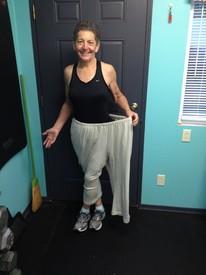Which way is better to calculate calories?

Blessed_Mommy86
Posts: 52 Member
Is it better to...
A: Calculate calories for a sedentary lifestyle without including exercise, then reduce calories by 15-20%, and eat back any calories burned during exercise (using a HRM with chest strap to determine calories burned).
or
B: Calculate calories with activity level included in the formula and reduce that number by 15-20% without eating back any calories burned.
I ask because I was told that option B is better. However, I feel like option A is better because some days I burn more calories than others. Therefore, I can eat accordingly. I will still be in a calorie deficit, but I won't be overeating if I only burn 100 calories that day. Conversely, I won't be under-eating if I burn 500+ calories. Any input is appreciated!
A: Calculate calories for a sedentary lifestyle without including exercise, then reduce calories by 15-20%, and eat back any calories burned during exercise (using a HRM with chest strap to determine calories burned).
or
B: Calculate calories with activity level included in the formula and reduce that number by 15-20% without eating back any calories burned.
I ask because I was told that option B is better. However, I feel like option A is better because some days I burn more calories than others. Therefore, I can eat accordingly. I will still be in a calorie deficit, but I won't be overeating if I only burn 100 calories that day. Conversely, I won't be under-eating if I burn 500+ calories. Any input is appreciated!
0
Replies
-
C. Set up your data in MFP. Set activity level excluding exercise. Eat all cals listed. Log exercise. Eat back half of exercise cals.12
-
This content has been removed.
-
Regardless of which method you choose, the numbers are all just estimates. So, pick one and log your calories as accurately as you can (take a look at the stickies if you haven't yet) for about 6 weeks. Adjust your calories up or down based on results.
Why don't you just start with MFP's formula, as suggested by PP? See how it works for you. Choose your activity level as provided in MFP's instructions - based on your life without exercise; that may be sedentary, but that shouldn't be the default. Add your exercise. Choose a percentage to eat back - that could be 100%, 75%, or whatever. But again, log your food as accurately as you can (weigh solids, measure liquids, choose accurate entries) and adjust after about 6 weeks.1 -
You should get pretty much the same number doing a or b. Personally I like b because I don't like trying to hit a moving target and B makes planning easier. But whichever works best for YOU is the correct way.1
-
Also voting for C. It gives you a solid, known baseline to work with and plan around, and you can easily add in more food to cover exercise cals.4
-
Given the three choices I would go with C, but if the question is whether to eat based on day to day calorie burn or to base it on your daily average then there are reasons to go either way. If you are burning a lot of calories through exercise then you are probably better off eating based on tracked exercise. But a method in which you eat based on your average burn allows you to form a habit of eating the same amount each day, making it easier to eat without tracking. But when exercising a lot performance can suffer if you don't eat to match activity.1
-
To be honest, option B really only works well if your exercise is consistent. Sometimes I just get busy and have to skip actual workouts. So option B doesn't really work for me. For instance, last week I had to push my workouts back by 3 days due to birthday party prep.2
-
If you workout 5-6 days a week, B is better I find.
I rather have the same amount of calories to eat a day, then worry about the number on my HRM all the time. Plus its nice to still get to eat the same number of calories on my rest day. It all evens out.
Of course you can adjust. My TDEE was a bit higher than the calculator I used, so for a month I lost faster than I wanted, added 100 calories a week until I was at my desired rate of loss and then used that number until I started to lose slower than my desired rate of loss.1 -
TDEE option is better (more simple rather than better) if you actually like eating the same level every day and your routine is very regular.
MFP method is better if you like eating different levels every day, your exercise routine is variable, or you do endurance cardio which needs fuelling on the day.
Both methods end up in the same place over time if done properly, neither method is better for everyone, just individual preference really.
But inherently the TDEE method is less accurate as you are also estimating duration of actual exercise performed whereas with the MFP method that's the one thing you know rather than estimate.
Both methods are likely to need fine tuning based on results but bear in mind the variance in results is just as likely to be due to food logging inaccuracy as exercise logging inaccuracy. It's the fine tuning that is as important as the method!
PS - Bear in mind that HRMs aren't accurate calorie estimating devices despite their marketing.1 -
I guess I am confused as to why I'd reduce my calories? Meaning if I am using MFP for weight loss that deficit is already built in. But I do A. Sedentary, count everything as exercise and eat back those calories. I do not use a HRM but I typically underestimate my calories burned.0
-
gamerbabe14 wrote: »I guess I am confused as to why I'd reduce my calories? Meaning if I am using MFP for weight loss that deficit is already built in. But I do A. Sedentary, count everything as exercise and eat back those calories. I do not use a HRM but I typically underestimate my calories burned.
Right, A and B are methods that do not use MFP, hence a subsequent poster gave option C, which is my vote as well, except I can eat all my exercise calories.2 -
I have always used the MFP way. Set my activity level and then add in any additional exercise. I don't have a set exercise routine, so it works best for me this way. For someone who doesn't exercise in a routine way, this offers the most nuanced calorie control.0
This discussion has been closed.
Categories
- All Categories
- 1.4M Health, Wellness and Goals
- 398.5K Introduce Yourself
- 44.7K Getting Started
- 261K Health and Weight Loss
- 176.4K Food and Nutrition
- 47.7K Recipes
- 233K Fitness and Exercise
- 462 Sleep, Mindfulness and Overall Wellness
- 6.5K Goal: Maintaining Weight
- 8.7K Goal: Gaining Weight and Body Building
- 153.5K Motivation and Support
- 8.4K Challenges
- 1.4K Debate Club
- 96.5K Chit-Chat
- 2.6K Fun and Games
- 4.8K MyFitnessPal Information
- 18 News and Announcements
- 21 MyFitnessPal Academy
- 1.5K Feature Suggestions and Ideas
- 3.2K MyFitnessPal Tech Support Questions












